Nippon: Authorial Presence - Hallo Guyst
Review Games Update, In the article you read this time with the title Nippon: Authorial Presence, we have prepared this article well for you to read and take information in it. hopefully the post content
Artikel Nippon, what we write can you understand. alright, happy reading.
Title :
Nippon: Authorial Presencelink :
Nippon: Authorial Presence
Baca juga
Nippon: Authorial Presence
 |
| Thorsten brags about size. |
It's been fun having authors Rüdiger Hoppe and Thorsten Suhr/Sommermnn visit my entries on Nippon, clearly enjoying the fact that someone is playing their 30-year-old game, while carefully--some might even say to a fault--avoiding spoilers.
Having played almost 25 hours of Nippon, it's hard not to feel like I already know them, what with their initials appearing in multiple island chains and town walls ("RTG" for "Rüdiger the Great" and "SFG" for "Suhr Fantasy Games"); these are mentioned on Thorsten's Nippon Museum as being as much copyright protection as self-glorification.
In the game, you meet Rüdiger's sister in one town:
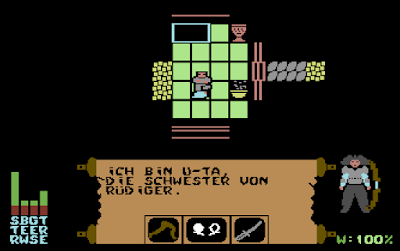 |
| "Bist du Single?" |
And then in the city of Funatabi, you run into the developers themselves, standing at the end of a long pier:
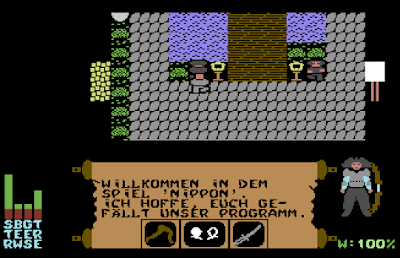 |
| I've been playing for over 20 hours! It's a little late to "welcome" me! |
I have to admire their restraint in not making themselves mikados, like Richard Garriott would have done. However, I do have to note that the developers have nothing to say if you approach them "friendly" or "normal." They only talk if you choose "submissive."
Having explored most of the game world at this point, I have to offer some praise for the design of the landscape and the towns. The settings that they created are as original, interesting, and evocative as possible with tiles. As you sail along, you encounter archipelagos of complex shapes, broken continents crisscrossed by rivers, valleys fully enclosed by mountains, and snow-capped peaks amidst pools of lava, all surrounded by a black void that sucks your ship over the edge if you sail too close.
 |
| I sail into a lake surrounded by lava surrounded by mountains surrounded by lava. |
Among the game's 30+ towns are Yogan Haikyo, a city in the midst of being destroyed by a volcano; Mizu-Do, designed like a giant spa; Kokoro-Kazan, a mountain city with tunnels hewed through the rocks; and of course Ulti-Tori, shaped like Ultima III's Sosaria. Every city has a unique and original layout that incorporates elements of the surrounding terrain and creates navigation obstacles for the player. For instance, in Funatabi, there's a hidden armor shop that requires you to buy a ship, sail it to the northwest corner, and walk through a bit of lava. Lots of other towns have areas only accessible via swimming or finding invisible doors.
 |
| A dying town riven with rivers of lava. |
I've been visiting these towns one-by-one as I continue my north-south exploration. I think I've logged 13 new ones since last time. I have to say, it's a bit exhausting to prepare to play this game, as I have to load my map (waiting for ArcGIS to load can take about half an hour by itself), then open and arrange the game window, my notepads, and my translation web site. This is definitely a game that requires two monitors and an Internet connection--something that's going to become a big problem if I don't finish it this week.
Once I have everything open, however, I fall into a certain rhythm. Visiting each city is roughly the same. To start, I explore more or less randomly, talking to NPCs as I find them, until I find the city map. Every city has one, and the developers did a good job varying how difficult it is to find them.
 |
| This one wasn't too hard to find. |
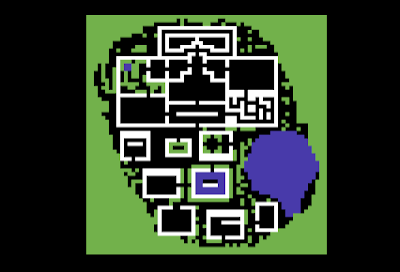 |
| The in-game town map makes it easier to plot a path. You have to visit not only all the buildings, but all the open areas as well. |
Once I have a screenshot of the map, I use it to plot a more systematic route through the town, trying to ensure that I don't miss any NPCs. A single missed NPC can mean serious trouble, and I'm sure I've missed plenty.
 |
| An NPC has nothing more to say to me after I bungle the approach. |
Here's where I cheat a bit. Once I encounter an NPC, I take a save state, then quickly run through the various dispositions, reloading the save state after each one. This is necessary because NPCs clam up at about half of your approaches, and the only way to reset them is to leave the town and re-enter. Even if they speak to you, they might not offer all their keywords unless you use the right approach. This isn't quite as bad as it sounds, because you sometimes have information from another NPC that suggests the one you're speaking with has more to say, and you sometimes get hints on the right disposition to use. Even with these considerations, it's pretty bad. I can't imagine completing the game under these circumstances on original hardware.
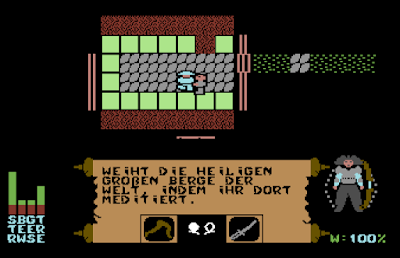 |
| An NPC offers a vital clue. |
Of course, even if I get them to talk, I have to translate the results. Their sentences are short enough that it's faster just to type them one by one than to get a massive text dump from the game file and to find, copy, and paste from there. Moreover, this far into the game, I only have to use the translator for about one-third of the words. No, that doesn't mean I'm "learning German." I wouldn't have a clue how to construct a sentence from scratch; I'm utterly lost on the gender of nouns, conjugations, and tenses; and of course I have no idea what these words sound like. But simple word recognition is becoming simpler.
 |
An NPC named Gandalf tells me about mittelerde.
|
Except for the most obvious throw-away pleasantries, I copy the NPC dialogue into a notepad. About 1 in 15 dialogues gives me some kind of "to do" item that I copy into a different section of the notepad. Many of these items concern cities I've already visited, but I've decided to save "backtracking" for when I'm done with my first pass through the game world.
Aside from that, I check out any new weapons and armor (I recently bought an expensive suit of "master samurai" armor, which creates a constantly-pulsing magic aura around regular samurai armor), re-stock keys, incense, and food, and buy the occasional night in an inn or massage at a spa. Incidentally, getting a massage, like sleeping with a prostitute, sometimes confers experience points.
 |
| I like to think there's some amusing German reason behind this. |
If the town has a treasure room, I typically re-visit it as many times as necessary to get my gold up to around 15,000 before moving on. The most lucrative so far has been in Kokoro-Hi, where you can get 2,500 gold per trip for the price of one key.
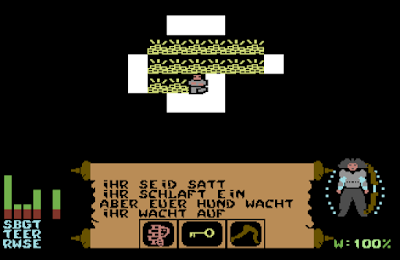 |
| Looting the treasury of an evil god. |
The main quest has become marginally clearer. It doesn't appear that the Wheel of Time is going to take me home, but rather to dates in which certain things happen at the game's various mountains. An NPC told me I should "consecrate the sacred great mountains of the world by meditating there," which will "call upon the gods who receive you, and prepare the way back." In Chuibukai, an NPC told me the specific date that I need to visit the mountain near its city.
 |
| The first piece of hard intel that I have. |
Operating the Wheel of Time just advances or rewinds the world, however. It doesn't magically transport you. So if you're going to go back 60 years, you'd better be at least 70 years old, or you won't be much use when you arrive. Ditto for going forward in time. I wondered why some of the magic shops offered the ability to age you as well as rejuvenate you, and now I know.
The problem is, I didn't come all the way here just to find the way back, did I? The manual made it sound like I was supposed to stop the emperor's marriage and keep both him and his bride from spending the rest of their lives in misery. I haven't heard anything else about them since the last entry.
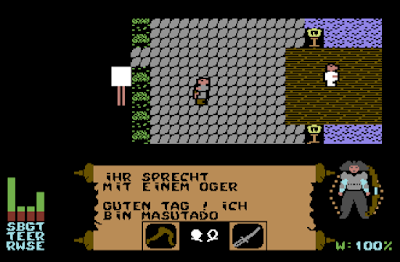 |
| Is this the NPC who was supposed to have more to say? |
Beyond that, the game has introduced more mysteries than answers. Here are the five major enigmas occupying my mind right now:
1. How spells work. I learned "magic" (generically) in the last session, but every time I follow NPC clues to find a spell, the game tells me that I'm missing some prerequisite to use it. The "cast" icon on my icon bar doesn't do anything.
2. This pair of items. I've found several artifacts during my travels. Most of them don't appear under the generic "use" button but instead add additional buttons of their own to an already-annoying icon set. This session, I followed several NPC clues to find a "magic ball" and a "mirror of the earth." To get the magic ball, I had to find a secret mountain pass into the "inaccessible island," which has an invisible wall around most of its perimeter, preventing landing.
 |
| As promised, I find a crystal ball under a palm tree at the end of a mountain pass. |
Anyway, the two artifacts seem to work together in some way. The ball cycles among 10 syllables--yonno, san, ni, chi, rei, kyu, hach, shich, roku, and go--and you select them to string them together into two lines of eight total syllables, like "Reigorokuchi Sannikyuchi" or "Hachreinisan Nichisango." The mirror, meanwhile, gives you one of these combinations when you look at it. But if you repeat what the mirror says on the ball, the disk just runs for a bit and nothing happens and I'm an idiot. I just figured it out while I was typing this. It's a teleportation device, isn't it? The mirror tells you where you are, and the globe lets you program a destination. The syllables represent coordinates. I'll have to experiment, but if I'm right, I don't see how the globe isn't horribly over-powered, obviating both flight and the "gate" system, which I also can't figure out.
 |
| I think I just understood what this means. |
3. Unsolvable side quests. The towns offer dozens of encounters that seem like side-quests but don't seem to give any option to solve them. For instance, in Chuibukai, there's a guy on an island who says he has malaria. In another area of town, there's a guy who says he has a cure for malaria. There's even a scroll on the floor of his office that suggests something that you might be able to pick up. But I can't find any way to unite the cure and the sufferer. In Yoga-Haikyo, a woman surrounded by lava screams at me to help her escape, but I can't think of any game mechanics that would allow me to do so.
4. The Gates. There are portals all over the game world. They apparently chew up one of your gate icons and age you a bit, but otherwise allow quick transport between towns or between select locations on the surface and towns. The problem is, I can't get any of them to work. Often, I can enter the initial portal and find myself in kind of a portal nexus, but after that, nothing I do--standing, pressing the mouse button, moving up, moving down, searching, using any of the icons--will let me through the other portals. I suppose this is moot if the globe works as I suspect it does or if I find the flying horse. And sailing doesn't take that long.
 |
| Okay, but how do I use them? |
5. My new status bar. Speaking to one of the Buddhas resulted in not an enhancement to an existing status bar but a brand new one, to the right of the existing ones. Moreover, there's a gap indicating a possible place for yet another one. The new bar is unlabeled, and I don't know what it's for. Nothing seems to budge it. I thought it might be for magic, but the "cast" icon still doesn't do anything.
Incidentally, I'm still confused about the difference between the shaded and unshaded portions of those status bars and will happily take explicit spoilers on the subject.
Late in this session, I finally found Mizu-Do and paid a sensei to teach me how to swim, adding another icon to the unwieldy icon bar. (Although as many as it has, I feel compelled to point out that it still doesn't have 26, meaning there's still no excuse for not mapping each action to a key.) About half my "to do" items involve returning to cities where you need to swim, including an entire city (Hinode-Tori) inaccessible without the skill. Swimming takes a rapid toll on health, so you can't do it for an extended period.
 |
| What an inhospitable place. |
Most of the rest of my "to dos" involve bringing various items to statues who demanded them. Most of these are weapons, so I've had to purchase half a dozen slaves to carry my excess. Statues also often demand food, so I've tried to keep a variety of food items. A few other tasks are dependent on finding the Amulet of Hi, which should allow me to walk through fire; that's in a city (Fujokawa) I haven't discovered.
 |
| Another statue wants a yari! |
I didn't mention combat much in this entry because it's become almost trivial. I blast a few enemies with my cannons or my bow when they won't leave me alone. Supposedly, the experience adds to my standing, which the game currently has me at gakusho, which my translator tells me means "forehead," so I'm not sure how good or bad that is.
I've visited several Buddhas during these voyages, and I've been good about leaving (rather than save-scumming) if I don't know the answers to their riddles. One question, for instance, told me that "a silver flute attracts wild animals" and wanted to know "what do these animals tell the user of the flute." This reminded me that I heard of a magic flute in Namazaki but never found it. I need to give it another try if I want to answer that riddle.
But I got most of them. One Buddha wanted to know why the connection between Watashibune and Funatabi no longer exists; having visited Funatabi, I knew it was because "the ferryman died." (Answering this correctly caused a bump to my mystery meter.) Another Buddha wanted to know how long the nights are in Nippon, as measured by hours. I solved this one in a silly way because I forgot that I had a clock. So I put the emulator in "warp" mode, waited for night to begin, timed its length, and timed when it began again. It lasted 15 seconds out of 60 total seconds for the day, or 25%, so I answered 6 hours and got it right.
 |
| It's a stupid answer, but I know the answer! |
As I wrap up, I'm in the city of Atatakami, home of the evil god Hachiman, who is "not home" right now. Hachiman supposedly stole the sun horse of the goddess Amatseru, and the horse can fly, making it possible to visit numerous places on the map ringed by mountains. Unfortunately, I can't seem to find the horse anywhere in the city. I'm getting ready to make another pass.
 |
| A snake attacks me as I enter Atatakami. |
Nippon has its moments. In basic structure, you could say that it's a lot like Ultima IV: visit towns, get clues from NPCs, fight monsters in between. But the game world is simply too big, and what happens in between the towns too uninteresting, and the character development too limited, to sustain interest for what probably will be at least 40 hours. I'm not eager to make a second pass through all of these cities if it turns out I missed some key clues, so if I don't know what I'm doing by the end of the next session, I'm going to start asking for explicit hints just so I can bring it to a close.
Time so far: 23 hours
At All Articles Nippon: Authorial Presence
Thanks For Reading Nippon: Authorial Presence this time, hopefully it can benefit you all. alright, see you in another article post.
You are now reading the articlel Nippon: Authorial Presence with link address https://reviewgameupdate.blogspot.com/2018/03/nippon-authorial-presence.html





















0 Response to "Nippon: Authorial Presence"
Posting Komentar